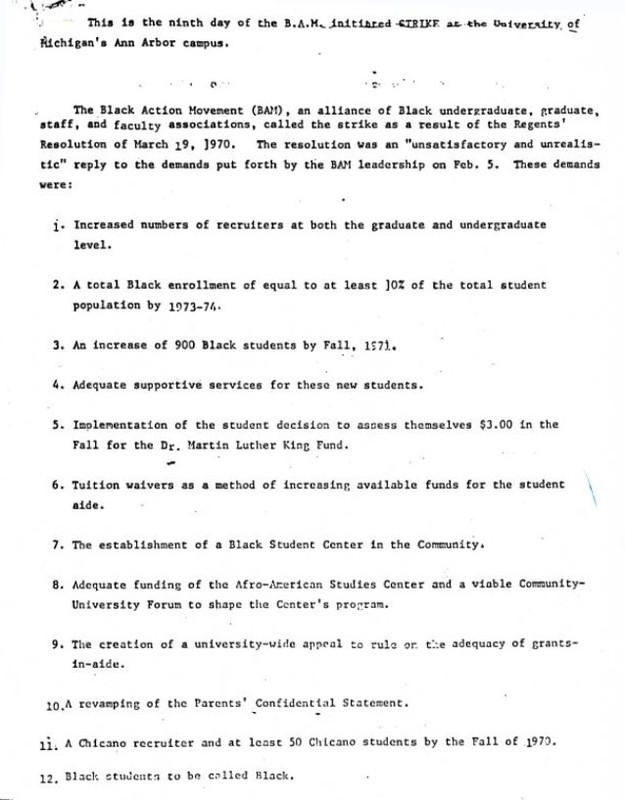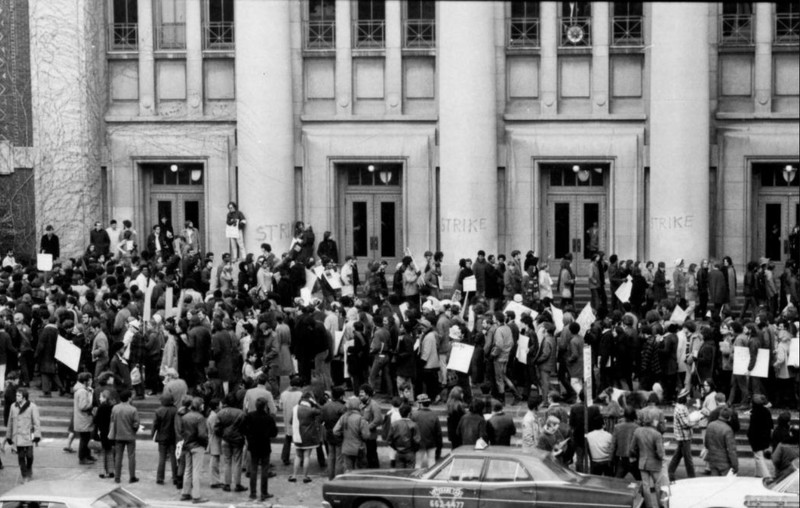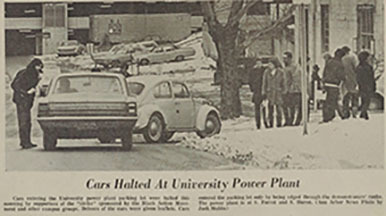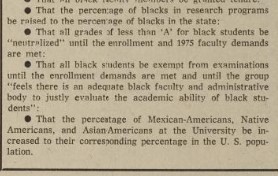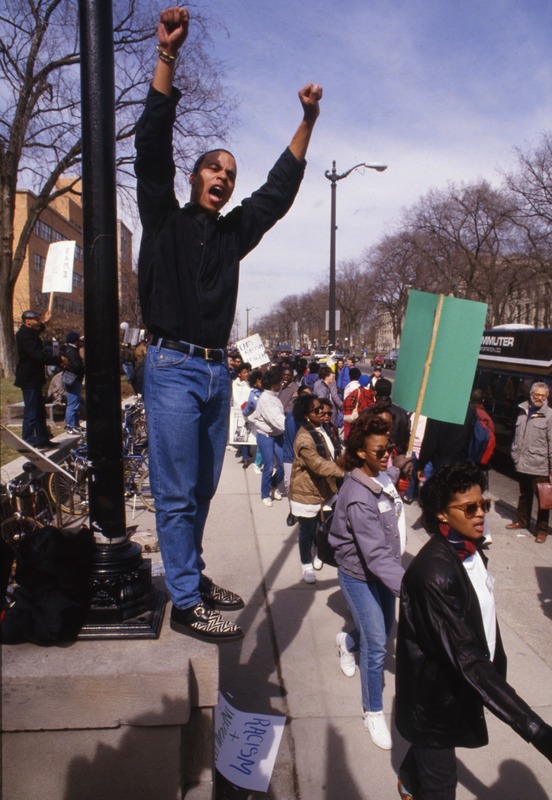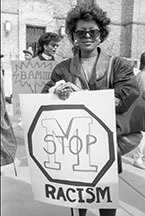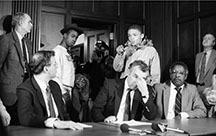The Black Action Movements (B.A.M.)
The Black Action Movement (BAM) refers to three different movements on campus between 1970 and 1987 that challenged the university’s policies regarding the recruitment, enrollment, and campus experience of minorities at the University. The four protest movements are often referred to as BAM I, BAM II, BAM III, and #BBUM. Although led primarily by Black student organizations, the protests represented the discontent of many minorities and received participation from many student organizations both Black and non-Black alike. While BAM was certainly not the only student-led movement during this period, it is regarded as one of the most challenging for university administrators and arguably the most influential in shaping the university’s diversity efforts and policies today.
Black Action Movements I -1970
In 1968, University of Michigan students protested the campus climate after the assassination of Martin Luther King, Jr. The Black Action Movement protests began in the fall of 1969. Black student groups, including the Black Student Union, Black Law Student Alliance, Black Student Psychological Association, and the Black Educational Caucus, started talks with the University of Michigan administration about campus climate.
In February 1970, the student protesters of BAM I made twelve demands, pictured above, of the administrators of the University of Michigan-Ann Arbor campus. Some of the demands included:
- Establishment of University commitment to 10% Black enrollment by 1973-1974
- Establishment of University commitment to hire Black faculty proportional to Black enrollment
- Establishment of supportive services for minorities
- Establishment of Black Student Center
- Establishment of recruiter for Chicano students
- Establishment of Black Studies Program
The students went on strike for 18 days. In an article in the Ann Arbor Chronicle on March 30, 2010 titled “Open It Up or Shut It Down,” Alan Glenn observed that the strike led to a 75% decrease in class attendance.
Gathering on the steps of Angell Hall after a meeting, in the picture above, students raised their fists in solidarity and in protest after voting to go on strike until their demands were met.
In addition to picketing classroom buildings, students set up picket lines at dormitories and other university buildings.
Lining around the block, cars in the image above wait while students block the street. As the protests continued they started having an effect on the operations of the University. Alan Glenn reported on how after President Fleming and the Regents refused to respond to the demands, about 25 protesters went to the Undergraduate Library and took hundreds of books off the shelves, forcing the building to close. The next morning BAM protesters met at the University administration building to demand action. President Fleming and the Regents once again refused, and a larger group of students went back to the library and disarranged thousands of books. Fleming responded by stationing Ann Arbor police officers at the University libraries. Over the next few weeks, more disruptions occurred including a blockade of the Michigan Union snack bar. Early in March, President Fleming announced an alternative proposal.
On April 1, 1970 the University responded to the students’ demands and the strike was settled.
Pictured above is a section of the minutes from the March 1970 Regents meeting stating the University’s response to the original twelve demands of BAM I. Of the twelve demands, the University accepted the 10% demand, the continued support of the Afro-American Studies Program, and the creation of a Black Culture Center.
Black Action Movement II - 1975
In 1975, students of color, once again feeling disillusioned by the lack of investment and commitment by the University of Michigan, protested. During February of 1975, for three days, nearly 300 students held a sit-in on the second floor of the Administration Building that contained the President’s Office. The three main reasons for the Black Action Movement’s second action were the lack of progress on implementing the demands of BAM I, in particular, the 10% enrollment of Black students; the expulsion of a Black nursing student without a hearing; and the rejection of a candidate for the dean of College of Literature, Sciences, and the Arts (LSA). Many people found BAM II to be a more mild protest than the earlier BAM I protest. In the Michigan Daily article “Sit-in ‘75: Ain’t the Old Days," David Weinberg interviewed university assistants and secretaries who remarked that BAM I felt more hostile and “threatening” while the BAM II sit-in felt more organized with “legitimate” concerns. During the sit-in, students created a list of demands to the university administration.
In these news clippings, pictured above from the February 19, 1975 issue of the Michigan Daily, the Black Action Movement II Demands are presented in two bulleted lists. The demands are transcribed from the newspaper below:
Demanded:
- The Third World Coalition Council be recognized as the sole bargaining agent for people of color in the University
- That Cleopatra Lyons be reinstated in the School of Nursing
- That the job appointment of the Native American advocate be raised from half-time to full time
- The establishment of an Asian American advocate
- The establishment of a Chicano cultural center
- Total amnesty from reprisals for demonstrators
The Third World Coalition Council calls for University negotiation on the following:
- That Blacks constitute 10% of student population by September, 1975; 13% by September, 1976; a percentage equal to or greater than the percentage of Blacks in the state by September, 1977; that each department be 10% Black; that the black student population be half male and half female
- That the percentage of blacks in the overall and individual Department faculties be 10% by September, 1975; 13% by September, 1976; a percentage equal to or greater than the percentage of Blacks in the state by September, 1977
- That all screening and preliminary examinations for applicants these faculty posts be “null and void” until the demanded percentages are met
- That the Black United Front be given general control of all admission, recruitment, and financial aid policies regarding blacks
- That money for black financial aid be increased by 30% immediately and those funds be increased “to meet the needs of black students”
- That the Black United Front Control all University services concerning Black Students
- That the Black United Front be given control of 25% of the University’s budget
- That the Black United Front be the sole bargaining agent for University blacks
University administrators met with the protestors to hear their concerns as they occupied the second floor of the Administration building.
Intently listening, University of Michigan president, Robben Fleming, sits with the student protesters to hear their concerns in the photograph above. After the three day sit-in, a group of representatives of Black, Chicano, Asian-American, and Native-American student groups presented six demands.
After the meeting, President Fleming released a statement to the BAM II’s concerns and demands, outlining his commitment to provide student services and financial support to students of color at the University of Michigan. The statement also promised continuing discussions with the Third World Coalition Council with the first meeting scheduled for four days after the statement was published. Furthermore, Fleming guaranteed that the students who took part in the sit-in would not face any punishment or criminal charges for occupying the Administration Building. The sit-in ended after President Fleming shared his statement.
Black Action Movements III - 1987
Seventeen years after BAM I, students were once again protesting the slow progress of the university in meeting their demands. The Black Action Movement III (BAM III) protests centered around four issues:
- Black faculty concerns about the racial climate on campus
- A WJJC radio disc jockey’s racist remarks
- University Housing's efforts to address harassment of Black students in residence halls
- University and Ann Arbor Police Department's handling of a fight at South Quad
In the image above, University of Michigan sophomore Michael Mason is pictured leading slogan chants, as student protestors lined the streets with poster signs. The posters that students carried shared messages that decried racism at the University of Michigan.
During BAM III, there were two groups making demands on the University administration, the United Coalition Against Racism (UCAR), and BAM III. BAM III’s demands included the following:
- We Demand the establishment and completely autonomous yearly budget of $35,000 for the Black Student Union
- We Demand the immediate endowment of $150,000.00 for the Monroe Trotter House to insure that the integrity of African American Culture will be preserved in spite of the vile climate of racism that persist at the University of Michigan
- We Demand that the university immediately grant tenure to all presently hired Black faculty, and develop an accelerated tenure program for all newly hired Black faculty. Furthermore, We Demand an increase of Black faculty members. Such that every department of the university has Black professors
- We Demand that the University Board of Regents and Administration adopt a plan which appoints Blacks as department chairs or heads of 30% of all academic departments of the university's schools and colleges. This demand applies to all undergraduate, graduate and professional schools
- We Demand the immediate addition of a racial harassment clause in the university’s rules and regulations to punish institutionally those who perpetuate, motivate and participate in any type of racist activity
- Full participation of the Black Student Union Executive Board in the formulation and implementation of any reform, program, or policy that implicitly or explicitly effects the black community of the university or our community at large
- We Demand that President Shapiro’s 1 million dollar initiative to improve the recruitment and retention of Black students be extended to a 5 million 5 year initiative. At the end of the 5 year period the initiative will be evaluated and possibly be extended indefinitely
- We Demand the development of a permanent Black music program and a Black Affairs program at all university owned student run stations. These programs shall be produced, programmed and operated by Black students
- We Demand that all university publications cease degrading and insulting the integrity of Black people by the use of the lower case “b” when referring to the Black Race
- We Demand the uncompromising ratification of UCAR’s Anti-Racism proposals
- We Demand total amnesty for all reprisals for students during B.A.M. III
In 1987, the University of Michigan administrators, all of whom had been hired after the original BAM I protests, found the protest to be a nuisance and largely ignored it. However the protest gained momentum with national news coverage and the administration was forced to respond to the demands of the protesters. But by March 19th, President Shapiro had met only one demand from UCAR: an honorary degree for Nelson Mandela. The BAM III’s demands went unaddressed.
Leaders of the Black Action Movement III were impatient and angry with President Shapiro's response to their demands. Finding it difficult to get the university administration attention, BAM III protesters interrupted a meeting between the University of Michigan president and regents.
Pictured above, protester Chuck Wynder confronts President Shapiro and U-M Regent Paul Brown, who appears aggrieved, during the meeting. Following the confrontation, civil rights activist and presidential candidate Jesse Jackson negotiated six concessions between the university administration, BAM III, and UCAR:
- Establishment of a Vice Provost for Minority Affairs
- $35,500.00 for the Black Student Union
- Funds for minority faculty development
- Plans and eventual targets for minority enrollment and faculty and staff hiring
- Development of a racial harassment policy
- Creation of an advisory committee on minority affairs to advise the university president
President Shapiro resigned the next month to become president of Princeton University.
Black Action Movement in the 21st Century - 2013
In November 2013, the Black Student Union launched #BBUM — a Twitter hashtag that stood for “Being Black at the University of Michigan.” The students asked other Black students to go onto Twitter and testify about their experiences on campus. The Twitter campaign gained national attention. Many of the tweets sounded like they could have come from Black students in the 1960s, 1970s, 1980s, and 1990s; it seemed like nothing had changed. Students carried protest signs that quoted the tweets to demonstrations.
In the image above, student Capri'Nara Kendall carries a sign at a demonstration in front of Hill Auditorium that reads “I’m more than just a wide receiver.” The demonstrations and the hashtag demonstrated how little had changed for students of color at the University of Michigan. Out of this movement, #BBUM provided a list of seven demands:
- We Demand the University to give us an opportunity to implement change. The change that complete restoration of the BSU’s purchasing power through an increased budget would obtain.
- We Demand the University make housing available on the central campus for those of lower socio-economic status at a rate that students can start to be a part of university life, and not just on the periphery.
- We Demand for an opportunity to congregate and share our experiences in a new Trotter (Multicultural Center) located on Central Campus.
- We Demand an opportunity to educate and be educated about America’s historical treatment and marginalization of colored groups through race and ethnicity requirements throughout all schools and colleges within the university.
- We Demand the equal opportunity to succeed with emergency scholarships for Black Students in need of financial support, without the mental anxiety of not being able to focus on and afford the University’s academic life.
- We Demand for increased exposure to all documents within the Bentley Historical Library. There should be transparency about the University and its past dealings with race relations.
- We Demand an increase of Black representation on this campus equal to 10%.
Many of these demands, like those calling for representation, financial support for Black students, and a safe, inclusive space for students of color, echoed and reverberated the demands of BAM I, II, and III.

Trotter Multicultural Center Background
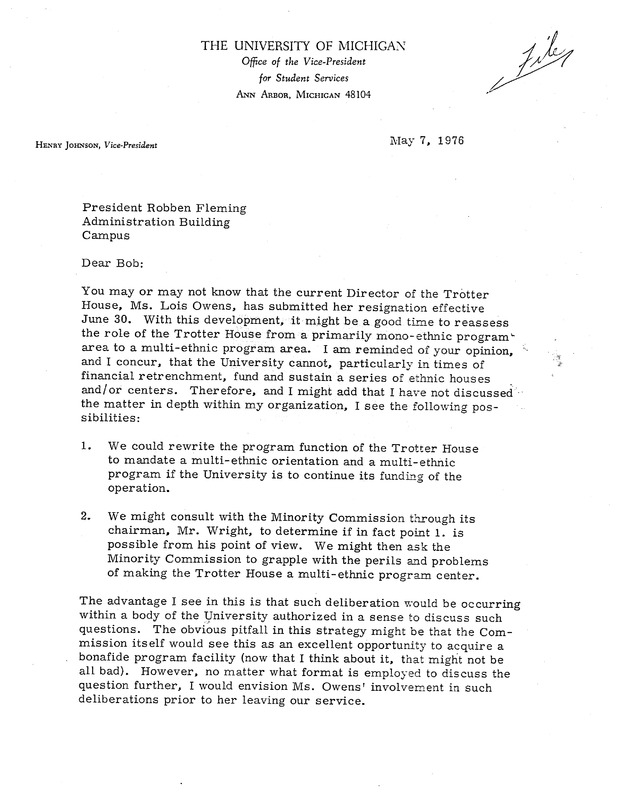
William Monroe Trotter Multicultural Center

